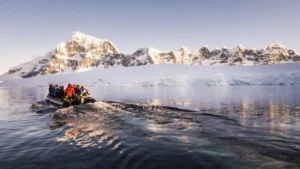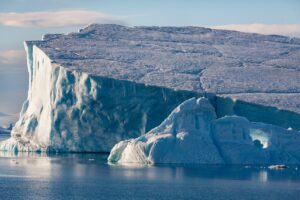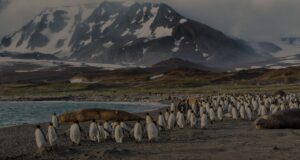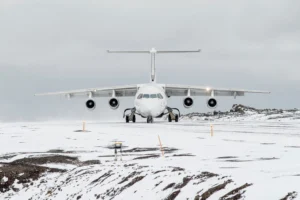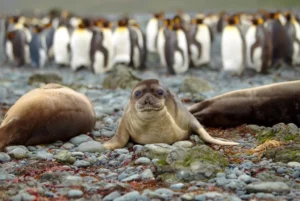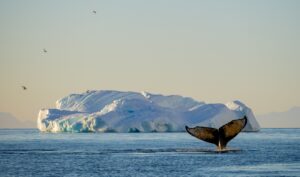
If you are considering exploring the frozen seventh continent in 2025 and 2026, our experts have created a comprehensive list of what to expect on your once-in-a-lifetime Antarctica holidays.
Despite its seemingly inhospitable environment encompassed in ice and snow, Antarctica is home to exquisite landscapes, extraordinary wildlife and otherworldly adventure.
Amongst the pristine and monumental glaciers that are unlike anywhere else on the planet, you will find whales gliding through the near-frozen waters, birds soaring across the clear blue skies overhead, and colonies of penguins and seals that are unfamiliar with humans, promising plenty of opportunities for up-close encounters with the residents of the White Continent.
For those who are considering or have booked an Antarctic adventure in 2025 and 2026, our seasoned travel specialists have crafted a guide on what to expect on your Antarctica holidays.

When is the best time to visit Antarctica?
The best time to visit Antarctica is between the months of early November to late March, as the days are at their longest and the wildlife is at its most active. Earlier in the season you will encounter more sea ice and the environment is more pristine, however access to some areas further south isn’t always possible. Later in the season the ice has receded, and you can travel further south, even below the Polar Circle.
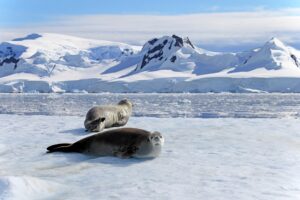
How many people will be on an Antarctic cruise?
The Antarctica cruise ships are much smaller than most people expect, carrying between 90 to 250 people onboard. Being smaller in size than a leisure cruise ship, the speed at which guests can disembark is improved, allowing for more time off the ship. Passengers can also expect a higher quality of service and bespoke experience that allows you to experience Antarctica to its full potential.

How to get to Antarctica?
Most Antarctic cruises set sail from the southern tip of Argentina at Ushuaia and journey straight across the infamous Drake Passage before reaching the northern tip of the continent, the Antarctic Peninsula. There are also a handful of cruises each season which fly to Antarctica from Punta Arenas in Chile to King George Island off the Antarctic Peninsula. There are also some cruises which depart from New Zealand and visit the Ross Sea.
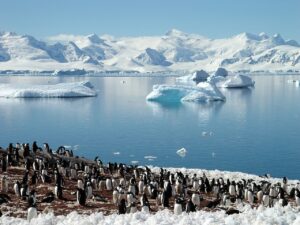
What wildlife will I see on an Antarctica cruise?
Penguins
Antarctica is home to a remarkable array of penguins including Gentoo, Adélie and Chinstrap penguins. Emperor Penguins, the largest species in the world can also be seen, but a few select places.
Best time to see the Antarctic penguins: December to February
Seals
Antarctica’s beaches are populated by six species of seals such as Antarctic Fur Seals, Leopard Seals, Ross Seals, Southern Elephant Seals, Crabeater Seals and Weddell Seals.
Best time to see the Antarctic seals: February to March
Whales
Humpback, Sei and Minke whales can often be seen in the Antarctic waters before migrating to warmer waters. You can also find other species included Orca, Southern Right Whales and even the largest animal on Earth, the blue whale.
Best time for whale watching in Antarctica: February to March
Birdlife
After passing the Antarctic Convergence, you will find a variety of extraordinary birdlife flying overhead such as the grey-headed albatrosses, black-browed albatrosses, light-mantled sooty albatrosses, cape pigeons, southern fulmars, Wilson’s storm petrels, blue petrels and Antarctic petrels.
Best time to see the birdlife in Antarctica: November

What places might I see on an Antarctic cruise?
Port Lockroy
You may get a chance to visit the former British research station of Port Lockroy, which is now a museum and post office on Goudier Island. Here you may be able to partake in activities around Jougla Point, meeting gentoo penguins and blue-eyed shags or when conditions are right, you can snowshoe around the shore.
Pléneau & Petermann Islands
If the ice allows it, you can sail through the Lemaire Channel in search of Adélie penguins, blue-eyed shags, humpback and minke whales as well as leopard seals. Kayaking, glacier walks and more ambitious mountaineering trips are great activities in Pléneau & Petermann Islands.
Neko Harbour
You can witness Neko Harbour, an epic landscape of mammoth glaciers and endless wind-carved snow. You will have the opportunity to embark on a Zodiac cruise that promises the closest views of the surrounding alpine peaks.
Deception Island
Part of the South Shetland Islands and to the north of the Antarctic Peninsula is Deception Island. As the caldera of a submerged volcano, it was named due to its deceptive appearance as a normal island. Once a popular whaling base, it is nowadays home to research stations and large volumes of Chinstrap penguins.
Snow Hill Island
Visited by very few travellers due to its remote location in the Weddell Sea, Snow Hill Island is almost entirely snow capped and is famously one of the few places where you can see Emperor Penguins.
Elephant Island
Similar to Snow Hill, Elephant Island is rarely visited due to its remote location and the near impossible weather conditions of the South Atlantic, but for the lucky few who do make it you can retrace some of the steps made by Sir Ernest Shackleton and his crew.
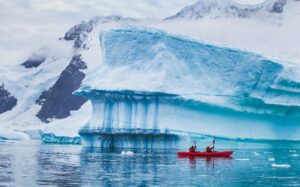
What will I do on an Antarctic cruise?
When you arrive in the pristine world of Antarctica, you will embark on:
Shore Excursions
All our trips to Antarctica include shore excursions in Zodiac boats and landings on the Peninsula and surrounding islands, promising an unforgettable opportunity to see the spectacular natural beauty and unique wildlife of Antarctica up close.
Enrichment Talks
Although the plan is to always have you off the boat as much as possible, whilst on board the expedition team will usually offer daily talks and presentations on the history, nature and wildlife of Antarctica. It all adds to experience and understanding of your environment.
Camping on the Peninsula
If you are interested, we can arrange for you to spend a night camped out on the ice like a true polar explorer in Paradise Bay.
Kayaking
For those with experience, kayaking is a wonderful way to see Antarctica from a different perspective. Slowly glide through the water, passing icebergs, penguins and even the occasional whale spout. Some open water kayaking experience is needed and it often has an additional cost, which means it does need to be booked in advance.
Snorkelling and Diving
Discover Antarctica from below the surface as you kit up in your dry suits and submerge yourself in the icy clear waters. Both are specialist activities and not available on all cruises, but for those with suitable experience it is an unforgettable way to experience the frozen wilderness.

Our top tips for planning an Antarctica cruise
1. Pick an itinerary and ship that best suits your needs
There is a lot of choice when it comes to planning a trip to Antarctica and it can be bewildering. The cheaper trips are often on larger boats and have shorter itineraries which means very little time in Antarctica (there is a limit of 100 people on Antarctica at any one time, so being on a boat of 500 passengers means you get a fifth of the landing time you would get on a smaller 100 passenger ship). We always recommend choosing a smaller boat with fewer passengers to maximise your time off the ship and on Antarctica, and ideally an itinerary which plans for at least four full days in Antarctica.
2. Expect the unexpected!
This is an expedition after all, and it really is true that no two trips to Antarctica are alike! Although your ship will have a ‘loose’ itinerary including areas they hope to visit, that can go out of the window on day one if the sea conditions change. Shore visits and activities all depend on the weather, meaning that your itinerary can change and evolve last minute. This is where an experienced Captain and Expedition Leader really come into their own.
3. Choose your additional activities in advance
Some ships offer optional activities including kayaking, camping, snorkelling and diving. They nearly always need to be booked in advance and get booked up, so if you would like to do any then best to confirm them at the time of booking.
4. Pack appropriately
Most ships will include an expedition parker and waterproof boots, which should be worn on every outing off the ship, but it is important to consider other items as well. Dress on board is generally casual and you will want to be comfortable. When off the ship make sure you wear layers (particularly waterproof trousers) and be prepared for all temperatures. One of the most important things to bring is a camera and a pair of binoculars!
5. Consider travelling to Argentina or Chile before or after Antarctica
As most trips to Antarctica depart from South America, why not spend some time there before or after your Antarctic expedition. You will almost certainly need a few days on the mainland before the cruise starts, but you may want a few days relaxing in a vineyard or an estancia at the end of your expedition on terra firma.
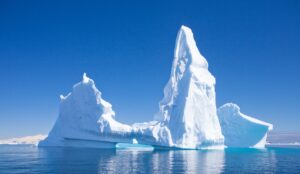
Plan your Antarctica trip today
Speak to one of our travel specialists to start designing your Antarctica holidays and cruises: +44 (0) 2039 933538 or make an online enquiry.

